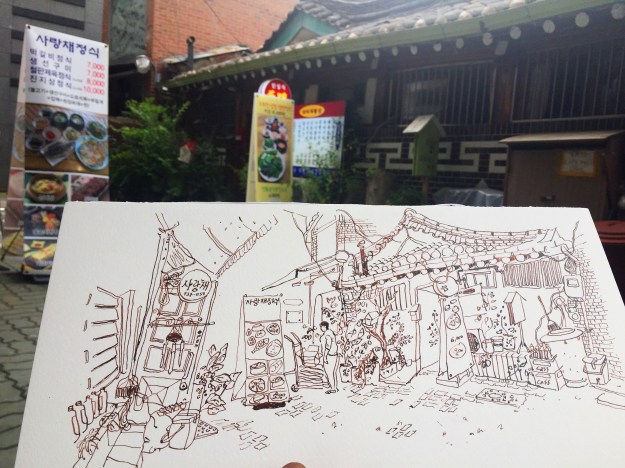lies in its alleys as I found out on one of my sketching trips.
I had been waiting to go out sketching for a while but I’m slowly realizing in my first year in Seoul that to wait for the perfect day in the months of July and August is to wait forever. After two weeks of oppressive heat it has been raining incessantly.
Needless to say that I arrived at Insadong on a rainy afternoon and after securing a map with tons of information about the area from the tourist office (out of exit 6 of Anguk Station), I decided to do away with it. The rain was turning it into pulp.
Lying straight ahead was the 700 meters long and 12 meters wide pedestrian (on weekends) street called Insadong Gil, stretching from Anguk-dong to Jogno 2-ga. It has a 7 meters tall Korean calligraphy brush sculpture at the beginning which I had already seen on my earlier visit.

Ajumma standing in front of her hanok and the neighbourhood delivery guy passing by
I was also done browsing through the street’s innumerable souvenir shops, folk handicraft stores, art galleries, Korean paper shops, had tipped my hat to world’s only Starbucks with its signage written in local language, visited a traditional tea house and checked out the quirky Ssamziegil mall.
As per the guidebooks I could have checked Insadong off my list of places to see. What more was there?
A curiosity laden turn away from the main commercial street into the atmospheric side alleys revealed the answer.
What I saw and then sketched seemed like an alternate Insadong, one I didn’t know existed – a watered-down version of the deeply cultural neighbourhood of 1930s selling antiques, books and art, way before its colonisation by coffee chains and cosmetic shops, before Korean war even.

Insadong 16-gil
First thing that hits you when you make this unplanned diversion is how quiet and empty the alleys are, a welcome respite from the neurotic busyness of the main strip. Barring a monk, a school girl and a delivery guy I hardly saw anyone. And then in the course of exploring this labyrinth of narrow arteries, one leading to another and sometimes ending abruptly in a cul de sac, you get a whiff of old Seoul that maybe gritty and rough around the edges but is authentic to the core.

One of Insadong’s many narrow alleys
With Insadong’s popularity with tourists in the recent years, rents on the main street have soared such that it can only be afforded by big commercial establishments, thereby pushing older, smaller businesses and artists to the winding back alleys laid out 500-600 years ago (dating back to the Joseon dynasty), where life is still quaint, unhurried and very ordinary.

Another beautiful alley in Insadong
I saw laundry drying on wires, potted plants outside wooden doors, beer bottles stacked in crates, cracked egg shells lying near a trash can filled to the brim, a plastic broom, a wind chime, music wafting out from open windows, someone napping on a red chair by the kitchen and pigeons hopping around, drinking rain water collected in little potholes where the road had caved in. An ajumma (as middle-aged Korean ladies are respectfully called) was standing in front of her hanok (old Korean cottages) turned restaurant, caressing a snarly lap dog and staring at me with utter intrigue.
I was sitting on the steps of a closed bar in an alley I had just wandered in, and had started drawing. For the longest time ajumma maintained a distance from me, trying to understand what I was doing while pacing outside an imaginary fence that seemed to be between us.

I got to work, started tracing lines with my eyes and then put ink on paper.
Slowly but surely. A bunch of Absolut Vodka bottles, window slats and a door emerged.
I am always amazed how drawing makes you lose all sense of time. You surrender to this repetitive cycle of seeing, comprehending and mark making. Everything else becomes invisible. I find this heightened sense of focus the only way to connect with my new environment. You get to immerse yourself so deeply and wholly in the process that when you emerge, you feel a kinship with the place you were drawing. It doesn’t look as foreign as it did when you started out.
I like to believe that by connecting with my environment in such a way I blend in and don’t look as foreign to it too and become an ordinary person sitting in the corner doing something innocuous. That’s when imaginary fences vanish. Ajumma comes over. The dog too. They are thrilled I drew their house. The dog shows its appreciation by not snarling at me anymore and Ajumma by bringing me a steaming cup of coffee in a paper cup.

A sketch and two steaming cups of coffee. I added the delivery guy later.
I must accept it, she insists. Then she takes my sketchbook and shows my sketch to her neighbours. They come closer to meet me. We huddle on the stairs, touch shoulders and giggle at our communicational ineptitude. Another cup of coffee is placed before me. When the neighbourhood delivery guy passes by, everybody raises their hands to wave at him.
I raise my hand to wave at him too, on impulse and realize that it doesn’t look out of place.









